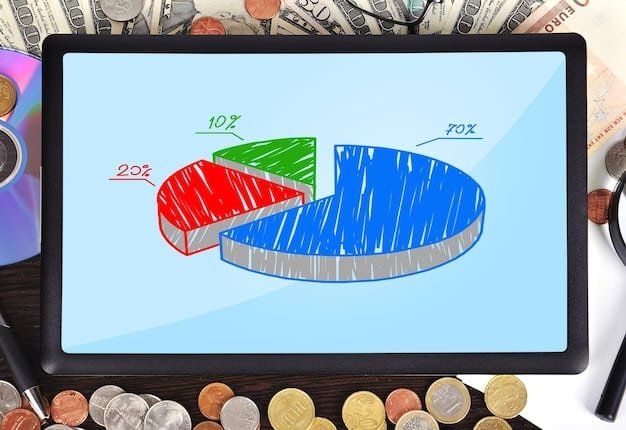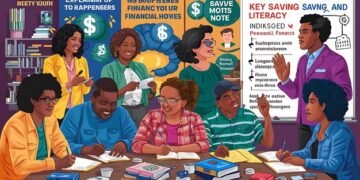Financial Literacy Programs in Schools: A 2025 Review for US Students

Financial Literacy Programs in Schools: A 2025 Review examines the evolving landscape of financial education for students in the United States, highlighting key initiatives, challenges, and opportunities for improving financial capabilities among young adults.
As the financial world becomes increasingly complex, the need for effective Financial Literacy Programs in Schools: A 2025 Review is more critical than ever, helping students in the US navigate their future financial lives with confidence.
The Growing Importance of Financial Literacy Education
Financial literacy is no longer just a desirable skill; it’s a necessity for young adults entering an increasingly complex economic landscape. Understanding personal finance concepts can significantly impact their future well-being by enabling better decision-making.
In 2025, the focus on integrating these programs into the standard curriculum reflects a growing recognition of this need. Let’s explore the current state and future directions of financial literacy in schools.

Why Financial Literacy Matters
Financial literacy empowers individuals to make informed decisions about their money. Without it, they are more vulnerable to debt and financial mismanagement.
Key Benefits of Early Financial Education
Starting early with financial education can cultivate habits that lead to long-term financial stability. It provides a foundation for understanding concepts that will become increasingly relevant as they age.
- Teaches students the value of saving and budgeting.
- Helps them understand credit and debt management.
- Provides foundational knowledge for investing decisions.
- Empowers them to avoid common financial pitfalls.
Ultimately, the goal is to equip students with the tools and knowledge they need to make sound financial decisions throughout their lives.
Current State of Financial Literacy Programs in US Schools
As of 2025, financial literacy programs vary widely across the United States. While some states mandate personal finance education, others leave it to individual school districts, resulting in a patchwork approach.
This disparity leaves many students without adequate preparation for managing their finances. Bridging this gap is a key challenge for educators and policymakers alike.
State Mandates and Curriculum Standards
States with mandates typically integrate financial literacy into existing courses like math or social studies. Some states are also developing comprehensive standalone courses.
Effectiveness of Existing Programs
The effectiveness of current programs varies, with some showing promising results while others struggle to engage students. This highlights the need for continuous evaluation and improvement.
- Programs integrated into math courses show better results in some states.
- Standalone courses tend to be more comprehensive.
- Teacher training is a crucial factor in program success.
- Engaging teaching methods are essential for keeping students interested.
The need to ensure consistent, high-quality financial education for all students remains a pressing issue nationwide.
Innovative Approaches to Financial Literacy Education
To enhance the engagement and effectiveness of financial literacy education, many schools are adopting new and innovative teaching methods. These approaches aim to make learning about money more interactive and relevant to students’ lives.
From gamification to real-world simulations, educators are finding creative ways to bring personal finance to life in the classroom.
Gamification and Simulations
Gamified learning and financial simulations allow students to practice financial decision-making in a safe and engaging environment. This can help them better understand the consequences of their choices.
Real-World Projects and Case Studies
Incorporating real-world projects and case studies can help students apply their knowledge to practical situations. This approach fosters critical thinking and problem-solving skills.

By making learning more relevant and interactive, these innovative approaches can help students develop a deeper understanding of personal finance.
The Role of Technology in Financial Education
Technology is playing an increasingly important role in financial education, offering new tools and resources for both students and teachers. From mobile apps to online courses, technology can make learning about money more accessible and engaging.
These platforms provide personalized learning experiences that cater to individual needs and learning styles.
Online Resources and Mobile Apps
Online resources and mobile apps offer interactive lessons, budgeting tools, and simulated investment platforms. These resources can supplement classroom instruction and provide ongoing learning opportunities.
Benefits of Personalized Learning Platforms
Personalized learning platforms can tailor the content and pace of instruction to meet the unique needs of each student. This can lead to better comprehension and retention of financial concepts.
- Mobile apps offer on-the-go learning opportunities.
- Online resources provide access to expert advice and guidance.
- Personalized platforms adapt to individual learning styles.
- Technology enhances engagement and makes learning more interactive.
By leveraging technology, schools can provide a more comprehensive and effective financial education for their students.
Challenges and Barriers to Effective Implementation
Despite the growing recognition of the importance of financial literacy, several challenges and barriers hinder its effective implementation in schools. Addressing these obstacles is crucial for ensuring that all students have access to quality financial education.
These challenges range from funding constraints to a lack of qualified teachers and curriculum integration issues.
Lack of Funding and Resources
Many schools lack the necessary funding and resources to implement comprehensive financial literacy programs. This can limit access to quality materials and teacher training.
Teacher Training and Expertise
Many teachers lack the training and expertise needed to effectively teach personal finance concepts. Providing adequate professional development is essential for program success.
- Funding constraints limit access to quality resources.
- Teacher training is often inadequate.
- Curriculum integration can be challenging.
- Parental involvement is often lacking.
Overcoming these challenges requires a collaborative effort from educators, policymakers, and community stakeholders.
Future Trends and Policy Recommendations for 2025 and Beyond
Looking ahead to 2025 and beyond, several key trends and policy recommendations can help shape the future of financial literacy education. These strategies aim to improve program effectiveness, expand access, and ensure that students are well-prepared for their financial futures.
From standardized curriculum to increased parental involvement, these recommendations offer a roadmap for enhancing financial education nationwide.
Standardized Curriculum and Assessment
Developing a standardized curriculum and assessment tools can help ensure that all students receive a consistent and high-quality financial education. This can also facilitate program evaluation and improvement.
Increased Parental and Community Involvement
Engaging parents and community members in financial education initiatives can reinforce learning and provide additional support for students. This collaborative approach can strengthen the impact of school-based programs.
- Develop standardized curriculum guidelines.
- Increase funding for financial literacy programs.
- Provide ongoing teacher training and support.
- Engage parents and community members.
By implementing these strategies, we can ensure that future generations are equipped with the financial knowledge and skills they need to thrive. A focus on financial literacy programs in schools: a 2025 review will highlight significant improvements and progress.
| Key Point | Brief Description |
|---|---|
| 💰 Importance of Financial Literacy | Critical for informed financial decisions and long-term stability. |
| 👩🏫 Current Program State | Varies by state, challenges include inconsistent implementation. |
| 🚀 Innovative Methods | Gamification and real-world projects enhance engagement. |
| 💻 Technology’s Role | Online resources and personalized platforms improve learning. |
Frequently Asked Questions
▼
▼
▼
▼
▼
Conclusion
In conclusion, financial literacy programs in schools are crucial for equipping students with the necessary skills to navigate the complexities of the modern financial world. As we look to 2025 and beyond, focusing on innovative approaches, leveraging technology, and addressing the challenges hindering implementation will be key to ensuring that all students have access to quality financial education. By doing so, we can empower future generations to make informed decisions and achieve lasting financial well-being.





